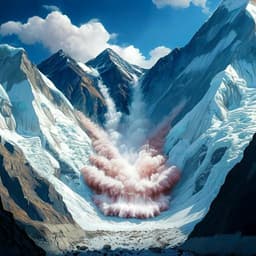
Earth Sciences
2023 Jishishan Earthquake-triggered river terrace landslide enabled by tectonic and human activities
Z. Zhang, R. Zeng, et al.
Discover the insights from the Jishishan earthquake of December 18, 2023, as researchers unveil the complex interplay of geomorphology, tectonics, and human activities in triggering a devastating landslide-mudflow in Jintian Village, China. The study by Zonglin Zhang and colleagues calls for immediate assessment of landslide risks in irrigation-prone, tectonically active regions.
~3 min • Beginner • English
Introduction
On December 18, 2023, an Ms 6.2 earthquake (depth ~10 km) struck Jishishan, Gansu Province, China, associated with reverse-type rupture on the eastern marginal fault of Jishishan within the Lajishan arcuate fault zone, active since the late Quaternary. Peak ground acceleration in the meizoseismal area reached ~0.477–1.071 g. Beyond building collapses, a landslide-mudflow on the Yellow River’s tertiary terrace rapidly inundated over 90 houses in Jintian Village, causing 20 deaths (59% of earthquake-related fatalities in Qinghai Province). The source area had very low relief (<3°) yet the flow traveled ~2.8 km, indicating significant underestimation of landslide hazard on low-angle irrigated terraces. Existing views emphasize loess liquefaction and lateral spreading, but field evidence shows complex stratigraphic contacts and missing sand layers, suggesting additional processes. Key unresolved questions include the hydrological pathway that saturated loess prior to the quake and the cause of differential liquefaction expressed by >6 m-deep liquefaction channels on a nearly flat slope. The study aims to determine failure modes and causes, boundary controls of the sliding source area, and kinematics, within the broader context that decades of irrigation along the middle–upper Yellow River have raised groundwater, increasing liquefaction susceptibility even in moderate earthquakes.
Literature Review
The paper situates the Jintian Village event among rare large-scale loess liquefaction cases in China, historically limited by deep groundwater prior to irrigation projects. Notable analogues include low-angle landslide-mudflows at Shibeiyuan during the 1920 Haiyuan M8.5 earthquake and the 2018 Palu M7.5 event in Indonesia, where irrigation raised groundwater near the surface in sandy alluvial fans. However, Jintian’s geological context (loess terraces with overburden units and active tectonic faults) differs. Prior studies on the 2023 Jishishan-triggered flowslides debated mechanisms (loess liquefaction versus sand surge, lateral spreading) and kinematics, with incomplete explanations for observed unconformities in overburden contacts and missing sand layers. Broader literature supports high liquefaction potential in saturated loess and in unconsolidated deposits (e.g., pumice, alluvium) under strong ground motion; irrigation can raise groundwater and predispose loess terraces to liquefaction. The authors highlight the gap: multi-material (dual) liquefaction failure on irrigated loess terraces under tectonic influence remains underrecognized.
Methodology
- Remote sensing and UAV surveys: Interpreted river terraces in the upper Yellow River canyon zone (Longyangxia–Qingtongxia) using 0.48 m Google Earth imagery, identifying human settlements and irrigated areas. Acquired post-event orthophotos (0.03 m) and DSM (0.14 m) with a DJI M300 UAV for Jintian Village, compared to pre-event imagery to identify surface changes, infrastructure displacement, gully widening, and deposit patterns; validated by field checks.
- DEM processing and thickness mapping: Used pre-event GF-1 DEM (5 m) and post-event UAV DSM (0.14 m), resampled both to 1 m in ArcGIS. Computed elevation errors using stable areas, interpolated corrections via kriging, and derived corrected pre-event DEM. Thickness of source-area modification was estimated by subtracting corrected pre-event DEM from post-event DEM.
- Hydrological and slope analysis: Generated 19 transverse profiles at ~20 m intervals across the source area on the pre-event DEM to delineate concavities and surface runoff channels; independently extracted post-event drainage using hydrology tools (Fill, Flow Direction, Flow Accumulation, Stream to Feature) and validated in the field. Computed pre-event slope classes; average source-area slope <3°.
- Preferential channel network mapping: Mapped tectonically induced crack networks and preferential infiltration channels through field identification of sinkholes, excavation faces, collapse planes, exposed sidewalls/backwalls, and sidewalls of liquefaction channels, informed by regional fault activity and historical seismicity.
- Stratigraphic profiling and thicknesses: Defined stratigraphy into overburden (planting soil, clay, sand, red clay) and underlying eolian loess. Measured thicknesses of overburden, sand, and red clay at backwall, western side, and eastern front-edge outcrops; integrated with DEM-referenced topography to construct thickness variation curves (Origin software).
- Failure boundary mapping: Delineated liquefaction, lateral spreading, landslide, and collapse extents using field GPS of residual sliding surfaces, backwalls, sidewalls, toppled overburden with intact stratigraphy, and liquefaction indicators (outcrops, water/material ejection). Distinguished loess vs sand liquefaction by contact relationships and integrity of overburden units, acknowledging overlap in profiles.
- Geophysics and geotechnical testing: Conducted two 2-D ERT Wenner arrays (300 m length, 5 m electrode spacing) in strongly vs weakly irrigated areas; inverted with standard software and calibrated with soil moisture from profiles and pits. Performed XRD (2–80°, 0.02° step) and SEM (1000x) on loess samples from weakly irrigated zones and near (~3 cm) vs far (~100 cm) from preferential channels. Measured undrained strengths via quadruple direct shear for loess (varying proximity to channels) and sand at different water contents; measured permeability coefficients for clay, sand, loess, and cracked loess via quadruple infiltration system.
Key Findings
- New dual liquefaction failure mode: Field profiles and 73 liquefied-layer outcrops show both loess and overburden sand layers liquefied, producing widespread unconformable contacts within overburden and explaining missing/attenuated sand layers. Southern source area mainly exhibited loess liquefaction where sand pinched out; northward, sand liquefaction increased. Loess liquefaction channels number four, with depths >6 m.
- Irrigation-driven saturation via tectonic preferential channels: ERT and ground truth indicate higher saturation in strongly irrigated zones; pits in the source area show near-saturated loess with ~31–35% water content at ~0.45–0.99 m depth. In weakly irrigated areas, groundwater depth ~7.5–8 m. Decades of flood irrigation infiltrated rapidly through tectonically induced crack networks (some >20 m deep), forming preferential channels filled with red alluvial material and having permeability far exceeding that of loess. This preferential flow elevated groundwater and saturated loess despite low-permeability overburden clays.
- Fabric degradation near channels reduces liquefaction resistance: SEM/XRD reveal strongest water–soil interaction near channels: dissolution pits, larger pores, increased clay content, and reduced soluble minerals (calcite, dolomite), leading to lowered structure-controlled strength. Cohesion decreased from ~34.2 kPa (weakly irrigated) to ~30.5 kPa (far from channels) to ~23.6 kPa (near channels) under low normal stresses (≤200 kPa). Increased porosity facilitates excess pore-pressure buildup under cyclic loading, driving loess toward liquefaction (S ≈ 0).
- Sand layer prone to undrained liquefaction when transiently saturated: Pre-event flood irrigation days before the earthquake likely saturated the sand layer, which is bounded by low-permeability clays, limiting drainage. Undrained shear tests at 100 kPa show sand strength at high water content (20.5%) is ~48.9% lower than at low water content (6.9%). Thin, shallow sand layers (<45 cm; <3 m burial) showed partial liquefaction, consistent with depth-dependent cyclic pore-pressure buildup and anisotropic yielding.
- Boundary controls by runoff and overburden: Surface runoff concavities mapped pre-event coincide with post-event loess liquefaction channels. Catchment capacity and channel dimensions decrease from front to rear of source area, limiting rearward propagation of liquefaction. Overburden thickness varies spatially (thicker at rear and eastern front edge, thinner westward and toward front), influencing consolidation, void ratio, and liquefaction resistance; lateral spreading dominated where overburden is thick, whereas deeper loess liquefaction occurred where overburden thinned/pinched out.
- Kinematics of a low-angle, ultra-long runout mudflow: Source-area slope <3°, transition slope <10°, apparent friction coefficient ~0.03. The flow destroyed an earth dam ~520 m downslope ~1–2 min after the quake and inundated villages ~1.8 km away ~10 min later, with total runout ~2.8 km. Initial high-energy front left impact marks up to ~10 m on the dam and ~4 m on houses. Much material ponded northward behind the dam (accumulation ~170 m long, ~85 m wide, ~1–2 m thick). Subsequent diluted mudflow (bulk density ~1.71–1.79 g/cm³) sourced by continuous discharge from liquefaction channels and accelerated through a narrow outlet, then confined within a narrow gully (circulation area), enabling ultra-long runout. Ice in the erosion area reduced friction early but was largely destroyed; the main channel farther downstream lacked a thick ice layer.
- Seismic and human drivers: The Ms 6.2 event had horizontal PGA ~0.477–1.071 g. The synergistic effects of long-term flood irrigation raising saturation and tectonically formed preferential channels enabled liquefaction on an exceptionally low-angle terrace. The event caused >90 houses to be submerged and 20 fatalities in Jintian Village, underscoring underestimated risk on irrigated river terraces.
Discussion
The study demonstrates that earthquake-induced landslides on irrigated river terraces can be dominated by dual liquefaction of loess and overburden sand layers, rather than by a single-material mechanism. Preferential infiltration channels created and sustained by regional tectonics allow decades of flood irrigation to rapidly saturate deep loess, degrade soil fabric, and lower liquefaction resistance near channels. Spatial variability in overburden thickness and pre-existing surface runoff pathways controls where liquefaction channels initiate and how far they propagate, thereby shaping the boundaries of the sliding source area. Kinematically, reduced bulk density from groundwater mixing, acceleration at narrow outlets, and confinement within gullies control long-runout behavior; early-stage ice can reduce basal friction locally but is not required to explain ultra-long distances once the flow is diluted and confined. These insights resolve controversies about missing sand layers and complex stratigraphic contacts, explain differential liquefaction on very low slopes, and highlight that hazard on irrigated loess terraces has been underestimated. The findings have broad relevance to other tectonically active, irrigated terrace systems globally, where similar dual liquefaction and kinematic processes may occur.
Conclusion
This work identifies and documents a previously underappreciated failure mode for earthquake-induced landslides on river terraces: dual liquefaction of loess and overburden sand layers enabled by the interplay of neotectonics and prolonged flood irrigation. Preferential crack networks formed by repeated seismic shaking act as rapid infiltration conduits, raising saturation and degrading loess fabric, especially near channels. Overburden thickness and surface runoff organization control the spatial limits of liquefaction and lateral spreading. The resulting low-angle, ultra-long-distance mudflow at Jintian Village was driven by diluted flow with reduced bulk density, accelerated through narrow outlets and confined in gullies. The study calls for urgent landslide potential assessments across irrigated river terraces in tectonically active regions, incorporation of dual liquefaction scenarios into hazard models, and targeted mitigation. Future work should quantify thresholds for dual liquefaction under varying overburden thickness, groundwater regimes, and seismic loads; improve mapping of preferential channel networks; and model coupled hydro-mechanical processes governing initiation and runout.
Limitations
- Liquefaction boundary delineation: Field evidence indicates overlapping liquefaction of loess and sand within the same profiles, making strict separation of their boundaries difficult. The mapped extents rely on contact relationships and outcrops and may retain uncertainty.
- Hydrological parameters: While relative permeability contrasts are constrained, some permeability coefficients and groundwater dynamics are inferred from tests and ERT calibrations; temporal variability (e.g., pre-event irrigation pulses) introduces uncertainty.
- Overburden effects: The study infers that overburden thickness modulates liquefaction resistance and failure style for the Jishishan event; however, the amplifying or damping effects under larger-magnitude earthquakes remain uncertain.
- Kinematic factors: The role of ice was localized and transient; quantifying its friction reduction versus dilution and confinement effects requires further instrumentation and modeling.
- Generalizability: Although the mechanism is argued to be broadly applicable to irrigated loess terraces with active tectonics, site-specific stratigraphy, irrigation practices, and tectonic histories may lead to different thresholds and extents.
Related Publications
Explore these studies to deepen your understanding of the subject.







